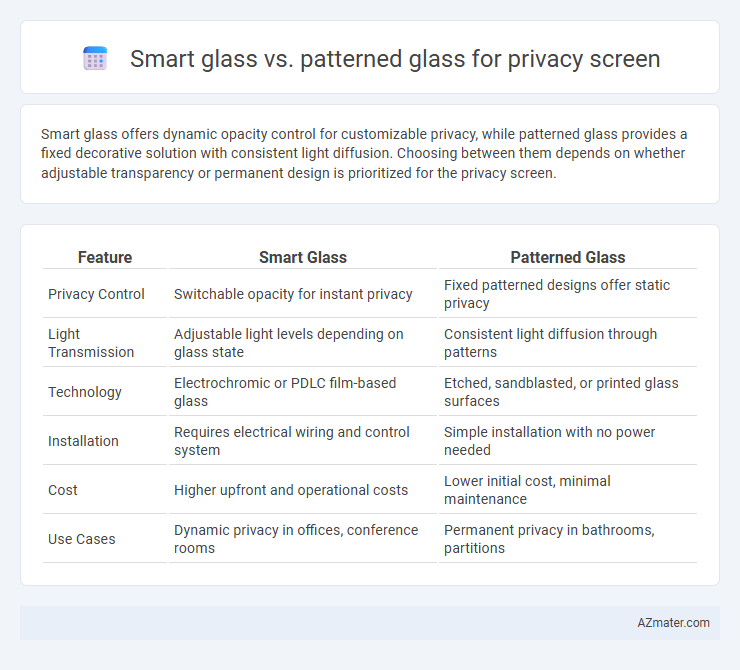Smart glass offers dynamic opacity control for customizable privacy, while patterned glass provides a fixed decorative solution with consistent light diffusion. Choosing between them depends on whether adjustable transparency or permanent design is prioritized for the privacy screen.
Table of Comparison
| Feature | Smart Glass | Patterned Glass |
|---|---|---|
| Privacy Control | Switchable opacity for instant privacy | Fixed patterned designs offer static privacy |
| Light Transmission | Adjustable light levels depending on glass state | Consistent light diffusion through patterns |
| Technology | Electrochromic or PDLC film-based glass | Etched, sandblasted, or printed glass surfaces |
| Installation | Requires electrical wiring and control system | Simple installation with no power needed |
| Cost | Higher upfront and operational costs | Lower initial cost, minimal maintenance |
| Use Cases | Dynamic privacy in offices, conference rooms | Permanent privacy in bathrooms, partitions |
Introduction: Understanding Privacy Screen Solutions
Smart glass offers advanced privacy control by electronically adjusting opacity, providing instant transition from transparent to opaque states, ideal for dynamic environments. Patterned glass achieves privacy through textured or decorative surface designs that obscure visibility while allowing light transmission, suited for static privacy needs. Both technologies enhance privacy screening but differ in flexibility, installation complexity, and cost-effectiveness.
What is Smart Glass?
Smart glass, also known as switchable glass, uses electrochromic, photochromic, or thermochromic technology to change its transparency when an electrical current, light, or temperature is applied, providing instant privacy control. Unlike patterned glass, which relies on static textures or designs to obscure views, smart glass offers dynamic opacity adjustments from clear to opaque, enhancing both functionality and aesthetics. Its ability to fine-tune privacy levels on demand makes it ideal for office partitions, conference rooms, and residential applications requiring customizable visual barriers.
What is Patterned Glass?
Patterned glass is a type of decorative glass featuring embossed or textured designs that obscure visibility while allowing light to pass through, making it ideal for privacy screens. Common patterns include rain, fluted, and reed, which create visual barriers without compromising natural light. Unlike smart glass, patterned glass provides a fixed privacy solution without electronic controls or transparency adjustments.
Privacy Performance: Smart Glass vs Patterned Glass
Smart glass offers superior privacy performance by instantly switching from transparent to opaque, effectively blocking visibility on demand. Patterned glass provides consistent but static privacy through etched or textured surfaces that diffuse light and obscure vision without electronic control. While patterned glass maintains privacy at all times, smart glass delivers customizable privacy levels, making it ideal for dynamic environments.
Aesthetic Appeal and Customization Options
Smart glass offers sleek, modern aesthetics with its seamless transparency-to-opaque transition, providing a minimalist look for privacy screens. Patterned glass enhances visual interest through etched or printed designs, allowing for extensive customization that complements various interior styles. Both options deliver privacy, but smart glass excels in dynamic control while patterned glass offers rich, customizable textures and motifs.
Energy Efficiency and Light Control
Smart glass offers superior energy efficiency by dynamically adjusting its opacity to regulate heat and natural light, reducing reliance on air conditioning and artificial lighting. Patterned glass provides fixed privacy and diffuses light but lacks adaptability, often resulting in inconsistent light control and higher energy consumption. Selecting smart glass enhances occupant comfort and lowers energy costs through precise, responsive light modulation.
Installation Process and Maintenance
Smart glass installation requires professional handling of electrical wiring and integration with control systems, making it more complex and costly compared to patterned glass. Patterned glass installs like traditional glass panes with standard framing, simplifying the process and reducing labor time. Maintenance for smart glass involves occasional electrical component checks and software updates, while patterned glass requires only routine cleaning and minimal upkeep.
Cost Comparison: Upfront and Long-Term
Smart glass upfront costs range from $100 to $200 per square foot, significantly higher than patterned glass, which typically costs $25 to $50 per square foot. Long-term expenses for smart glass include potential maintenance and electricity usage, while patterned glass incurs minimal ongoing costs due to its passive nature. Overall, patterned glass offers a more budget-friendly option initially and over time, whereas smart glass provides advanced privacy control at a premium price.
Ideal Applications for Smart Glass and Patterned Glass
Smart glass is ideal for conference rooms, healthcare facilities, and luxury residences where adjustable privacy and light control are essential, allowing users to switch between transparent and opaque states instantly. Patterned glass suits areas requiring permanent privacy with decorative appeal, such as office partitions, bathroom windows, and retail storefronts, offering a variety of textures that obscure visibility while enhancing design. Both materials enhance privacy but cater to different needs: smart glass for dynamic environments and patterned glass for consistent, stylish concealment.
Choosing the Best Privacy Screen for Your Needs
Smart glass offers dynamic opacity control through electrochromic technology, allowing users to switch between clear and opaque states for customizable privacy. Patterned glass provides a static solution with etched or printed designs that obscure visibility while maintaining natural light transmission. Selecting the best privacy screen depends on factors such as desired flexibility, budget, installation environment, and how frequently privacy settings need to change.

Infographic: Smart glass vs Patterned glass for Privacy Screen
 azmater.com
azmater.com